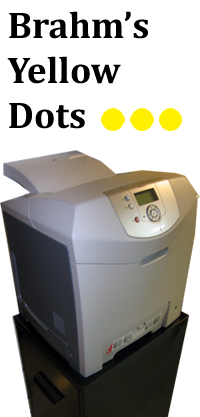Lexmark C530 Serial Number 9416FX1 (rendered in Photoshop to show dots visibly)

It's ridiculously obvious. Here are some rectangles colored over the pattern:

This really makes the pattern pop out. The dots are in a 21x8 matrix. The pattern is always the same - patterns from previous prints are identical to this scanned and rendered image. Therefore, it's impossible that date information is encoded into the pattern on Lexmark printers, just serial numbers.
I was on campus today, and found two more Lexmark color laser printers.
Lexmark C752 - Serial Number 940FNX2 (rendered in Photoshop to show dots visibly)

The green boxes are separate occurrences of the pattern; they cover the entire page just like my printer.
It's harder to see dots on this page because the print quality was poor; I am sure both of these campus printers have printed thousands more sheets than mine. Because the clarity of the pattern varied, I had to draw a massive grid to make sure I wasn't missing any dots from one square to the next. I was careful to ignore "noise" and only focus on repeating dots.
Lexmark C760 - Serial Number 940KG8H (rendered in Photoshop to show dots visibly)

I put everything into Excel to try and make sense of the patterns:

I'm temped to think that since the grid is 21x8 on all printers, and each serial number is seven characters, that each character is encoded by three columns of the pattern. For example, because the first six columns are identical on all three of the printers I've tested, the first three columns could mean "9" and the next three could mean "4".
I haven't had the time to really thoroughly check it out, but here's the information for the world to see.

So anyone with a lexmark laser printer will be able to be incriminated if we can snap their s/n off their printer, or get anything they've printed they threw out and we fake the dots on a non-dotting printer...
ReplyDeleteProbably the irony of a "security" feature.
Also Lexmark having the cheapest printers (I hate them, POS software mostly), I'm sure they're in many many places.
Hey Brahm, nice find!
ReplyDeleteWhat do you think is the encoding on these bits? The pattern is very sparse (if it were a simple binary encoding, half the bits should be '1': and in that case, you would be able to store a single character in a single 7-bit column (maybe 6bit, if it came down to it).
Opinion?
It could very easily not be encoding the serial number. The first 6 bits could encode the fact that it's a Lexmark, at which point law enforcement could contact Lexmark with the remaining bits, which could act as a key to a database.
ReplyDeleteI found this,
ReplyDeletehttp://incrediblefacts.com/technology/laser-printers-spy-on-you-for-the-government/
It's not much. but I hope it helps.
Howdy commenters,
ReplyDeleteWhen I was originally researching this issue, the dot pattern had been cracked for a few Xerox colour photocopiers, but I couldn't find any documentation on Lexmark machines.
I never decoded the Lexmark pattern because the goal of my venture was to be a loud-mouthed consumer and elicit a response from the company. If you check out the later posts on this blog, you can see what that earned me! (spoiler alert: an offer of a refund)
Wasn't this serial number pattern on color laser printers a request from the US Secret Service to combat counterfeiting schemes ?
ReplyDelete@Anonymous (latest post) Yes, it was. But, it's strange how there is no documentation on this "request" anywhere!
ReplyDeleteAnd, strange how foreigners (I live in Canada) are subject to the same tracking dots!